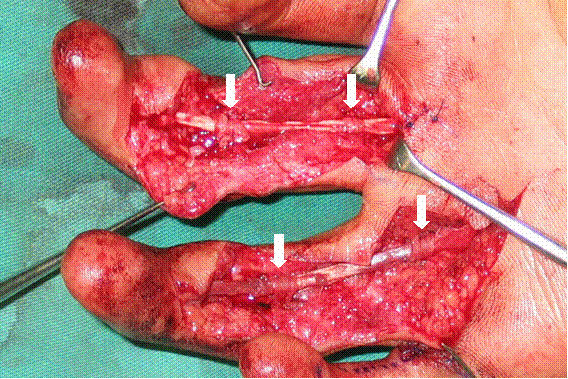Sunday, October 10, 2004
5529
Cadaveric Fascia Temporalis Graft for Pulley Reconstruction
Introduction: Pulley system plays an important role in controlling the effect of range of motion at the joints in the flexor tendon system. Successful reconstruction of a flexor tendon requires synchronous restoration of the pulley system, giving priority to A2 and A4 pulleys. Various options are offered as graft materials to reconstruct a pulley, but none of them is considered to be ideal. We present a case in which solvent dehydrated cadaveric fascia temporalis was used as a graft to repair A2 and A4 pulleys in two fingers. This material is considered to be extremely safe concerning the risk of transmitting HIV or CJD virus.
Case Report: A 17 year old boy with a flexion deformity in his third and fourth fingers was operated on. Flexion ability of these fingers was minimal since age of seven when he had a hand injury followed by a reconstruction. The previous surgical procedure had been performed at a different hospital, and unfortunately was unclear. At operation, complete exploration of the fingers revealed that all of the pulleys were destructed and a 6 cm tendon defect was present at the fourth finger. Defect was repaired with a graft from extensor tendon of the second toe. A 2x4 cm solvent dehydrated cadaveric fascia temporalis graft (Tutogen Medical GmbH of Germany) was used to reconstruct A2 and A4 pulleys of both fingers by suturing graft materials to the rim of the destroyed pulleys, a technique described by Kleinert and Bennett. (Figure 1) Each pulley was prepared approximately 5 mm in width, which is the recommended width of a reconstructed pulley. By the aid of a vigorous Kleinert rehabilitation protocol, the patient is able to flex his fingers effectively 3 months after operation, (Figure 2) and he is quite satisfied with the result.
Conclusions: Tissues such as tendons, extensor retinaculum, palmar plate of the PIP joint are widely used for pulley reconstruction. The restrictive factors are donor-site morbidity and for multiple pulley defects, availability of these autologous tissues. Various artificial materials (Dacron, silicone, PTFE, etc.) have been utilized to overcome these drawbacks with limited success. A reconstructed pulley must hold the tendon as close to the underlying bone as possible without restricting gliding. Solvent dehydrated cadaveric grafts are extensively used in several reconstructive procedures and are accepted as safe materials today. One of them, fascia temporalis is a comparatively thin graft, prevents tendon bowstringing effectively and have excellent gliding function. We propose it as an alternative for multiple digital pulley restorations.
 |
Figure 1: Intraoperative view of reconstructed pulleys.
 |
Figure 2: The range of motion of the patients fingers at postoperative month 3.
View Synopsis (.doc format, 192.0 kb)
